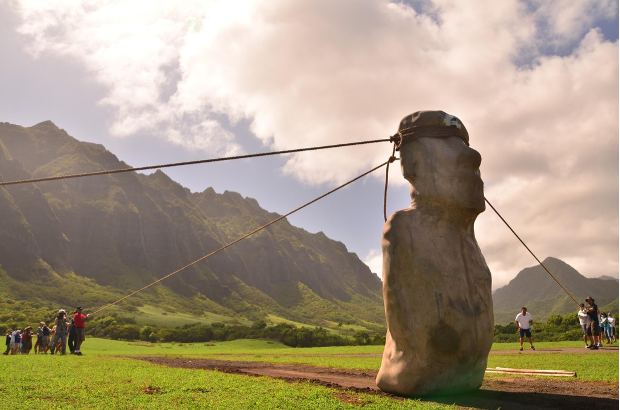How Easter Island’s moai statues walked themselves into history
New research shows Rapa Nui’s moai “walked” upright using rope and teamwork, revealing ancient Polynesian engineering genius.

Using 3D modeling and field experiments, researchers led by Binghamton University archaeologist Carl Lipo have verified that the ancient Rapa Nui people moved the island’s massive moai statues upright by “walking” them into place. (CREDIT: Carl Lipo)
For generations, the massive moai of Easter Island, called Rapa Nui by the locals, have stood in quiet testimony to one of archaeology's longest-standing mysteries. How did an island society, remote in the Pacific with no metal tools or beasts for heavy labor, transport hundreds of statues made from volcanic stone, some of which had a mass of over 70 tons, over rugged ground?
Increasingly, evidence now suggests a simple but elegant solution: the moai wandered.
A New Way of Looking at the Giants
The hypothesis is fanciful-sounding, but sound science backs it up. Researchers led by Binghamton University anthropologist Carl Lipo and University of Arizona archaeologist Terry Hunt used the sciences of physics, 3D modeling, and field experiments to prove that the Rapa Nui probably moved the statues upright, leaning them forward in zigzag lines.
Previous travelers assumed that the statues were dragged on sleds or rolled upon logs, a process which would have required an enormous amount of wood—something the island never had in abundance. But this new design reverses this supposition. Instead of force, it suggests balance, rhythm, and cooperation.
"The physics holds," Lipo explained. "As soon as you get it in motion, it is not hard at all—people are pulling with one arm. It conserves energy, and it moves really fast. Getting it rocking in the first place is the tough part."
Testing the Theory
To test if the theory would be effective, Lipo's crew constructed a 4.35-ton replica moai with the statue's characteristic forward lean and D-shaped base—traits they hypothesized were design features that enabled "walking." With a mere 18 people and some ropes, they were able to "walk" the replica 100 meters in 40 minutes.
The movement was similar to a man rocking back and forth and proceeding. As soon as the rocking motion of the statue had been initiated, the momentum did most of the work. As opposed to dragging, this process utilized little friction and did not damage the base. The group learned that the large statues, despite being so enormous, might have even been easier to move because their height gave more leverage for the rope teams.
According to estimates by mathematicians, small groups of humans managed to move statues a few kilometers in weeks with nothing but muscle memory and coordination. It was, quite literally, an engineering dance.
Roads for Giants
The island roads of ancient times verify this theory. Archaeologists found that the roads from the quarry of Rano Raraku to the coastline were ever so slightly concave, about 4.5 meters wide—perfectly suitable for holding statues as they creaked on the rocking motion.
"Every time they're moving a statue, it's like they're building a road," Lipo stated. "The road is part of moving the statue. We're watching them blocking each other—multiple parallel manifestations. They were probably pushing through, moving the statue, pushing through another and continuing.".
That connection between road and statue points to a culture that planned and prepared its landscape for a monumental work. The moai were not just relocated across the island; they defined it.
What the Fallen Moai Tell Us
Dozens of moai line the old roads, many broken or face-down. Some scientists once believed that they represented ritual routes or were deliberately placed as spiritual sentinels. Statistical analysis has another tale to tell.
Some 43 percent of the statues fell in the first kilometer from the quarry, and 65 percent within two. The closer to the source, the more fallen moai. This decreases gradually, showing accidents during transport, and not planned positioning.
Most of the fallen statues are facing front, and point downhill or away from the quarry—precisely what would happen if a pedestrian moai lost balance and fell while moving.
Even the few stone platforms discovered beneath fallen moai, once thought to be shrines, likely served as resting bases during transport breaks. They show the Rapa Nui’s logistical precision, not religious ritual.
Resources and Ingenuity
Critics of the walking theory once argued that deforestation in Rapa Nui made it improbable that islanders could have created the miles of rope required. The researchers respond that the fibers were from hauhau (Triumfetta semitriloba), a resilient shrub that thrived where ground had been disturbed, and not trees. Although forests were eliminated, hauhau would have grown in abundance—and continue to do so on the island today.
This small but significant piece of data confirms the manner in which the Rapa Nui successfully adapted to their environment. Instead of depleting their resources, they created a process that was cyclical and sustainable.
The magic of the walking theory is its physics. With each group tugging alternately at one side or the other, the statue pendulum-swinged. The center of mass stayed low and tilted forward, stabilizing the statue. With the swaying started, it required surprisingly little effort to keep it going.
This efficient system explains why so many statues—some over 30 feet tall—could have been moved across long distances without mechanical tools. The study also shows that their distinctive shape wasn’t arbitrary. Their narrow tops, rounded bellies, and convex bases all made “walking” possible.
A New Respect for Rapa Nui’s Achievements
For far too long, foreigners wrote the Rapa Nui themselves cutting down forests willy-nilly to move their statues and driving themselves into the ground. Lipo's book re-tells that story entirely.
"It shows that the Rapa Nui people were highly intelligent," he explained. "They knew it. They did it in a way appropriate for the resources that were available to them. It really does credit those people."
Instead of prodigal waste, the walking moai show ingenuity, sustainability, and cooperation. The islanders utilized physics naturally through coordination and cooperation to achieve movement from tons of rock.
Science in Motion
The walking moai hypothesis doesn't merely tell us how statues were moved—it demonstrates what scientific archaeology can achieve when theory and experimentation meet. As Lipo put it, "People have spun all sorts of tales that sound good, but they never go about figuring out if the evidence supports them. One of the steps is just to say, 'Look, we can construct an answer here.'"
This approach—creating testable, falsifiable hypotheses—marks a shift from speculation to science that is verifiable. When experiments, models, and field data meet at a point, the result is not just a story but a demonstration of how ancient wisdom crosses paths with modern analysis.
The Giants That Walked
Together, the findings create a vibrant portrait of the moai as not being stones but performers in a human drama. The Rapa Nui did not pull their ancestors back—they brought them home. Each statue was a living testament to ingenuity, balance, and cooperative toil.
No other explanation weaves together so many strands of evidence: the physics of locomotion, the highways, the overthrown statues, the design elements, and the available materials. The theory of walking renders what was once an apparently impossible accomplishment into one that is possible and falsifiable, based on experiment and data.
Through science and respect for Rapa Nui culture, the moai have marched again—not just in experiments, but in the way that humans, with limited means, can move mountains.
Practical Implications of the Research
This study does more than it deciphers a centuries-old mystery. It draws attention to how ancient societies used intuitive engineering, environmental intelligence, and collaboration to accomplish great things. The walking moai approach, rooted in physics and sustainability, has lessons for engineers and scientists today.
It keeps in mind that innovation doesn't always need high technology—sometimes it's rhythm, balance, and common sense.
The research also brings honor to the Rapa Nui people, presenting them not as victims of overexploitation but as masters of clever design whose creativity still guides problem-solving today.
Research findings are available online in the Journal of Archaeological Science.
Related Stories
- Easter Island’s volcanoes are older than the ocean floor
- Archaeologists decode the secrets of the Great Sphinx
- Breakthrough AI brings all Seven Wonders of the Ancient World back to life
Like these kind of feel good stories? Get The Brighter Side of News' newsletter.
Joshua Shavit
Science & Technology Writer and Editor
Joshua Shavit is a Los Angeles-based science and technology writer with a passion for exploring the breakthroughs shaping the future. As a co-founder of The Brighter Side of News, he focuses on positive and transformative advancements in AI, technology, physics, engineering, robotics and space science. Joshua is currently working towards a Bachelor of Science in Business and Industrial Engineering at the University of California, Berkeley. He combines his academic background with a talent for storytelling, making complex scientific discoveries engaging and accessible. His work highlights the innovators behind the ideas, bringing readers closer to the people driving progress.



